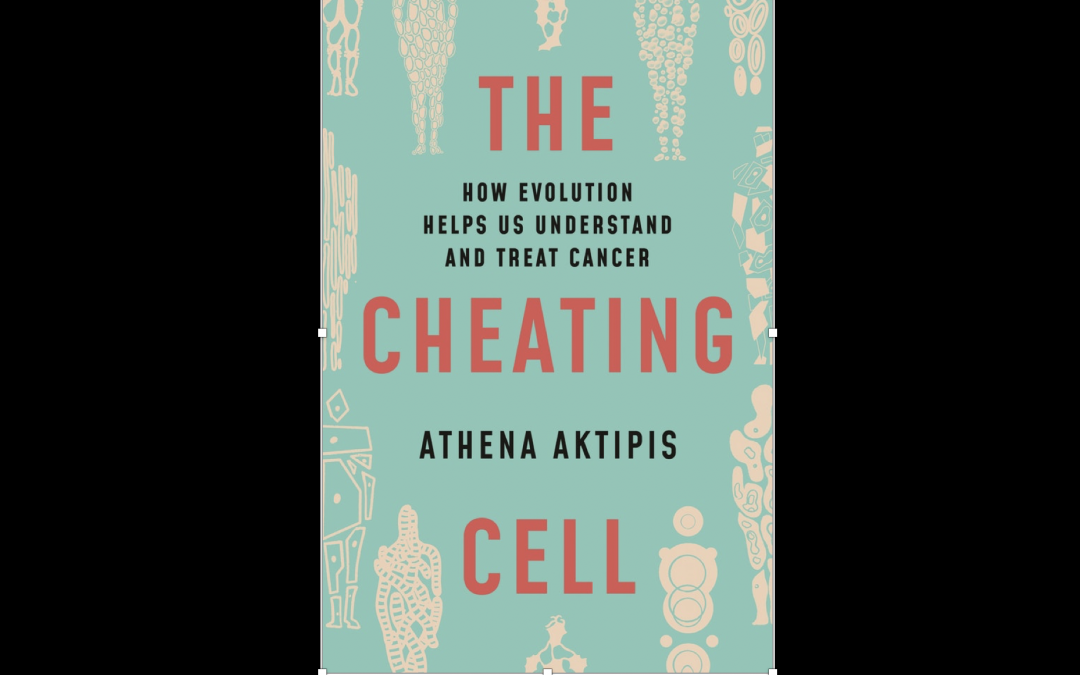Published by Princeton University Press, March 2020
When we think of the forces driving cancer, we don’t necessarily think of evolution. But evolution and cancer are closely linked, for the historical processes that created life also created cancer. The Cheating Cell delves into this extraordinary relationship, and shows that by understanding cancer’s evolutionary origins, researchers can come up with more effective, revolutionary treatments.
What inspired you to write The Cheating Cell?
AA: I wanted to write a book about cancer that was more than just an academic summary of cancer; I wanted to show how cancer is fundamentally tied into who we are as multicellular life forms, and to explain how our ability to treat cancer effectively is based on our understanding of the evolutionary and ecological dynamics underlying it. Really, I wanted to write an epic story about what cancer is, how it emerged during the origins of multicellular life, and how we can use evolutionary and ecological approaches to better prevent and treat cancer. It was also very important to me to write a book that would be accessible to a broad audience without sacrificing scientific rigor.
What is the book about?
AA: The Cheating Cell is a book about a new way of looking at cancer. It is about the fundamental evolutionary and ecological underpinnings of the disease. And it is also a book about the ways that cancer is entwined with our very existence as multicellular organisms. We are essentially made of cellular cooperation. Each of us is a cooperative cellular society of about 30 trillion cells descended from the fertilized cell that gave rise to us. In a healthy body, these cells cooperate to make us function effectively as multicellular organisms. But sometimes this cellular cooperation can break down, and when it does, cancer can arise. In The Cheating Cell I explain the many ways that cellular cheating can arise and how this cellular cheating can evolve in the ecosystem of the body. I also take a look at how our bodies have evolved (because of selection among organisms for better cancer suppression system) to deal with the threat of cellular cheating. I end the book by showing how new evolutionarily-informed approaches to cancer hold the promise for changing how we treat cancer and helping us to live longer and more fulfilling lives even with a diagnosis of the disease.
How can cells in our body cooperate and cheat when they presumably don’t have consciousness or intentions?
AA: When I talk about cells cooperating or cheating, I don’t mean to imply that there is any intention behind their behavior. In the case of the normal cells in our body working together to make us function, the cells in our body perform all sorts of amazing feats of coordination and cooperation, including sharing resources throughout the body and dividing labor (every one of our different cell types does a different job to keep us functional and healthy). Our cells also cooperate by restraining their rates of division, which allows us to help maintain our tissues without growing out of control. Cancer represents a breakdown of all of these aspects of cellular cooperation (and more). None of this cellular cheating involves consciousness or intention on the part of cancer cells. It is simply evolution happening within the body, favoring those cheating cells because they can replicate more quickly and monopolize resources, giving them a survival advantage. Of course this evolutionary process inside the body can ultimately undermine the viability of the organisms of which the cancer cells are a part. But, because cancer cells do not have the ability to consciously look to the future, they essentially evolve themselves into a evolutionary dead end. Cells don’t consciously or intentionally cheat, instead they evolve to cheat because the cells that cheat can have higher evolutionary fitness within the organism, which allows them to increase in frequency. It’s evolution 101, happening inside the body among cells that vary in their traits. Unfortunately, cells that cheat can get an evolutionary leg-up on the normal cells around them, leading to the emergence of cancer.
In your book you say that susceptibility to cancer is simply part of being a multicellular organism. Does this mean that cancer is inevitable?
AA: Cancer is part of our evolutionary legacy. It is part of the evolutionary legacy of every multicellular organism on this planet. But this does not mean cancer is an inevitability. In fact, our long evolutionary history with cancer means that we, as multicellular organisms, have actually evolved many defenses against cancer (this is because selection operates among organisms in a population, favoring those organisms that have more effective cancer suppression systems). For example, we humans have 2 copies of the cancer suppressor gene TP53 that helps protect against cancer by initiating DNA repair – and if necessary cellular suicide – in cells that are behaving abnormally. Cancer defenses like the gene TP53 can be thought of as cellular cheater detection systems, monitoring cells for signs of abnormal proliferation, unusual metabolic patterns, aberrant proteins or any other signs of suspicious behavior that suggest cellular cheating. Some large organisms like elephants have extra copies of cancer suppressor genes (elephants have 40 copies of TP53, many other large and long-lived organisms have other ‘extra’ cancer suppression genes). The work we have been doing looking at cancer across the tree of life suggests that large and long lived organisms have more sensitive cellular cheater detection systems, which help protect them from cancer. This is simply a reflection of a fundamental reality of cooperation theory: the larger the group and the longer it is around, the more vulnerable it will be to cheaters taking over. If you want it to last, there need to be effective systems for monitoring and regulating cooperation. Large multicellular organisms are essentially a giant cooperative group facing a fundamental social dilemma, where cheaters (in this case, cancer cells) can benefit from exploiting the group (the organism). And they have evolved special systems for keeping this cellular cheating under control long enough so that they can effectively survive and reproduce.
You point out that cancer happens across the tree of life, including in plants like cacti. Can you tell us more about crested cacti?
Crested Cactus
Crested saguaro cactus, Carnegiea gigantea (Lon & Queta, Crested Saguaro Cactus with Half Moon Behind; SE Arizona is licensed under CC-BY-NC-SA 2.0)
AA: A wonderful project that grew out the book and the work I’ve been doing looking at cancer across life is the “Endless forms most beautiful” cactus garden. It shows that we humans are not alone in our struggle with cancer. Plants, like these beautiful crested cacti, can harbor cancer-like growths as well. These cancer-like forms happen as a result of mutation or damage to the meristem (the stem-cell like cells on the growing tip of the plant) that lead to many unusual fan-like patterns, called “fasciations.” And these plants can live with these cancer-like growths; they do not necessarily threaten the lives of the plants, though they can make them more vulnerable. Crested cacti require extra care because they are more delicate, but they are also highly prized by botanists because of their unique and beautiful patterns. We created the garden as a place to appreciate how we share the burden of cancer with all multicellular life forms. It is also a place to come to remember loved ones who were impacted by cancer, and a place to appreciate the beauty of these unique growth patterns formed by the mutated cells. This garden is also an inspiration to keep innovating in our approaches to cancer, looking for ways to keep it under control so that we can live with it, as our ancestors have since the beginning of multicellular life on this planet.
What are the most important opportunities for using evolutionarily informed approaches to treat cancer?
AA: My colleagues and I are now working to bring clinical trials of evolutionarily informed therapies to Arizona. One of those therapies is called ‘adaptive therapy,’ an approach pioneered by Robert Gatenby at Moffitt Cancer Center in Florida. Adaptive therapy is aimed at keeping cancer under control rather than trying to eradicate it. Adaptive therapy avoids the often inevitable evolution of therapeutic resistance that often undermines the effectiveness of therapy because cells evolve resistance in traditional therapy. (This just like what happens if you spray a field with pesticides: you select for resistant pests.) The goal of adaptive therapy is to extend patient life, focusing on keeping the tumor under control rather than eradicating it. This is an approach that some people aren’t emotionally comfortable with because they just want to eliminate the cancer with high dose therapy. But often it is not possible to eradicate the cancer because resistance evolves and treatment stops working. So there is a tremendous opportunity here to change our mindset about cancer, and an evolutionary approach is central to that on two different levels. First, we need to recognize that cancer is an evolutionary system and that resistance is likely to evolve. Our treatments should, from the very beginning, include a plan for how to manage resistance and ideally keep the treatment effective for as long as possible. Adaptive therapy is one such approach. And second, we must come to terms with the reality that cancer is part of our evolutionary legacy, and that we as multicellular organisms have evolved with cancer, but as a result we have also evolved various ways of keeping cancer under control. Approaches like adaptive therapy have been successful at keeping advanced metastatic prostate cancer under control for years in the trials that have been done at Moffit. These are very exciting developments, and I think there is great promise in shifting our focus to controlling cancer and away from eradicating it.
Will we ever find a cure for cancer?
AA: The fact is, cancer is here to stay, it will always be a part of life on earth, and our best bet is to accept that it is a part of our evolutionary legacy. As we move forward, we can develop treatments and preventative measures that acknowledge cancer’s evolutionary nature and the many important ways cancer has shaped life on this planet. I think that in the future we will all think about what a cure means differently; that the idea of ‘cure via control’ will come to be the norm, rather than ‘cure via eradication’ which is the current way that people typically think about it. All of us, cancer patients or not, harbor cells with cancer mutations, but most of us are able to keep those mutated cells under control with our toolbox of cancer suppression systems. So cancer control is the normal state for multicellular life forms – ourselves included. By switching our attention from eradicating cancer to simply keeping it under control, we can change the way we think about a cure for cancer, and in the process make finding a cure much more likely.
Athena Aktipis is assistant professor in the Department of Psychology and in the Arizona Cancer Evolution Center at Arizona State University and cofounder of the International Society for Evolution, Ecology and Cancer. She is also the host of the science podcast Zombified. She lives in Tempe, Arizona. Twitter @AthenaAktipis





